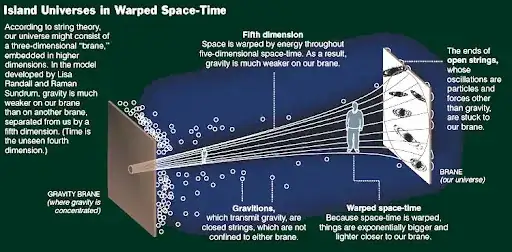This is nearly a duplicate of large-extra dimensions questions, you can see the answer here. The theories that predict that gravity is weak because it has extra dimensions are the large extra dimensions theories.
The reason gravity gets weaker is that gravity obeys a version of Gauss's law, which states that the outward gravitational field integrated over a large surface is equal to the mass inside (up to pressure corrections--- this is the Newtonian gravity, but the Einstein gravity is qualitatively identical in its scaling).
If you have a sphere of radius R, it's volume goes like $R^d$ by dimensional analysis, where d is the number of dimensions. The surface area goes like $R^{d-1}$ because it's the derivative of the volume with respect to the radius (the surface area is the volume enclosed by two spheres of infinitesimally different radius divided by the infinitesimal radial difference). So the total gravitational field times $R^{d-1}$ is equal to the mass, so that the gravitational field falls off as $R^{d-1}$ where d is the number of spatial dimensions. For 3 dimensions, it falls off as $R^2$, and this is Newton's universal gravitation.
In higher dimensions, gravity falls off faster. So if there are extra dimensions, and only gravity can propagate in these dimensions, gravity gets weaker quickly until you reach the scale where the extra dimensions are curled up. This means that gravity is weaker than other forces to the extent that the extra dimensions are large.
This type of theory must lower the Planck scale tremendously in order for this to be the dominant explanation of gravity's weakness, and in these circumstances, it runs into problems with non-renormalizable corrections, which should have already been observed. This is discussed in the linked answer.
Within standard string theory however, a miniature version of this mechanism allows gravity and the other forces to unify at a slightly lower energy scale than the Planck scale, nearer to the GUT scale, because the size of the extra dimensions is seen to be non zero around there. Lowering the Planck scale by one or two orders of magnitude in this was is not controversial, and was suggested by Witten in the 1980s, long before large extra dimensions were proposed.
